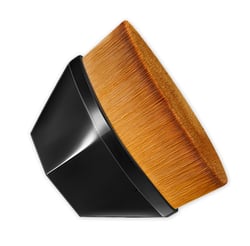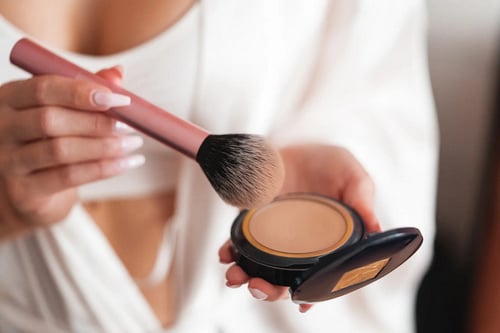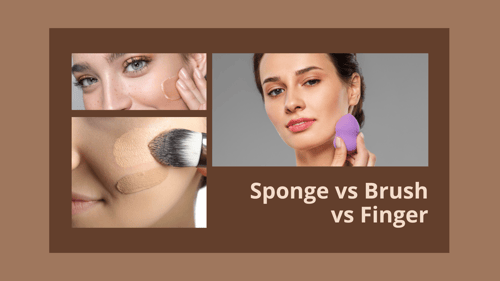Makeup is not just a routine, it’s an art form. And the key to achieving a flawless look lies in using the right brush. Whether you’re a makeup enthusiast or a professional artist, having the perfect brush can make all the difference in your final result. In this article, we’ll delve into how to select the ideal makeup brush for your skin type and product, explore various types of brushes available on the market, and provide tips on cleaning and maintaining your brushes for long-lasting use.
Types of Makeup Brushes
There are various types of makeup brushes categorized by their material, shape, and purpose. Selecting the appropriate brush can greatly affect the end result of your makeup application. Familiarizing yourself with the different types of brushes will assist you in choosing the most suitable tools for your makeup routine.
Based on Material
- Synthetic brushes: These brushes are made from synthetic materials, such as nylon or taklon. They are popular because they are affordable, easy to clean, and do not absorb as much product as natural hair brushes. Synthetic brushes are also hypoallergenic, making them a good choice for people with sensitive skin.
- Natural hair brushes: These brushes are made from animal hair, such as goat, horse, or squirrel. Natural hair brushes are prized for their softness and ability to pick up and distribute product evenly. They are typically more expensive than synthetic brushes and require more maintenance, such as regular washing and conditioning.
- Sable brushes: Sable brushes are made from the hair of the sable, a type of weasel. They are considered the highest quality natural hair brushes because they are extremely soft, durable, and able to hold a lot of product. Sable brushes are also more expensive than other types of natural hair brushes.
- Pony hair brushes: Pony hair brushes are made from the hair of ponies or horses. They are softer than synthetic brushes but not as soft as sable brushes. Pony hair brushes are a good choice for applying powder products, such as blush or bronzer.
- Boar hair brushes: Boar hair brushes are made from the hair of pigs. They are stiff and often used for applying and blending cream or liquid products, such as foundation or concealer. Boar hair brushes are also good for exfoliating the skin.
- Angled brushes: Angled brushes are typically made from synthetic materials and have a slanted shape. They are designed for precise application of products, such as eyeliner or brow powder. Angled brushes are also useful for contouring and highlighting.
- Blending brushes: Blending brushes are usually made from natural hair and have a fluffy, rounded shape. They are used to blend out harsh lines and create a soft, diffused look. Blending brushes are commonly used for eyeshadow, but can also be used for blush and other powder products.
Based on Shape and Purpose
- Powder brush: A powder brush is a large, fluffy brush that is used for applying loose or pressed powder. It can also be used for setting makeup and blending out harsh lines.

- Contour brush: A contour brush has a slanted shape and is used for creating definition and dimension on the face. It can be used to apply contour powder or cream products to the hollows of the cheeks, temples, and jawline.

- Blush brush: This brush has a rounded shape and is used for applying blush or bronzer to the cheeks. It allows for precise application without over-applying the product.

- Foundation brush: This brush has a flat, tapered shape and is used for applying liquid or cream foundation. It allows for smooth and even coverage, and can be used to build up layers for a more full-coverage look.

- Fan brush: This brush has a fan shape and is used for applying light, sweeping strokes of powder or highlighter. It can also be used for removing excess product, such as fallout from eyeshadow.

- Highlighter brush: This brush has a tapered or fan shape and is used for applying highlighter to the high points of the face, such as the cheekbones, nose, and cupid’s bow.

- Eyeshadow brush: There are several types of eyeshadow brushes, including flat shader brushes, fluffy blending brushes, and angled crease brushes. Flat shader brushes are used for packing color onto the lid, while fluffy blending brushes are used for blending out harsh lines. Angled crease brushes are used for creating definition in the crease of the eye.

- Lip brush: A lip brush is a small, flat brush that is used for applying lipstick or lip gloss. It allows for precise application and helps to prevent smudging.

- Buffing brush: A buffing brush has a dense, rounded shape and is used to blend liquid or cream foundation into the skin. It provides an airbrushed look and helps to blur imperfections for a flawless finish.

- Angled brush: An angled brush has a slanted shape and is used for applying products with precision, such as eyeliner or brow powder. It allows for a smooth and even application.

- Detail brush: A detail brush has a small, pointed shape and is used for applying products to small areas, such as the inner corner of the eye or the lip line. It allows for precise application and helps to create a defined look.

- Angled detail brush: The angled detail brush is a small, pointed brush that is used for applying products to small areas, such as the inner corner of the eye or the lip line.

- Smudge brush: The smudge brush is a small, rounded brush that is used for smudging and blending eyeshadow or eyeliner for a soft, smoky effect. It’s also great for creating a gradient effect along the lash line. The bristles are typically soft and fluffy, allowing for a gentle touch and easy blending.

- Stippling brush: This brush has a flat top and is used for applying liquid or cream products, such as foundation or blush, with a stippling motion. It creates a natural, even finish without leaving streaks or lines.

- Crease brush: This brush has a tapered shape and is used for applying and blending eyeshadow in the crease of the eye. It helps to create depth and dimension in the eye makeup look.

- Kabuki brush:
A kabuki brush has a rounded, dense shape and is used for applying powder products, such as bronzer or setting powder. It provides full coverage and a seamless finish.
Choosing the Right Brush for Different Makeup Products
Choosing the right brush for different makeup products is crucial for achieving a flawless look. Here are some tips and tricks for selecting the right brush for each product based on its texture, finish, and coverage level:
Foundation
When choosing a brush for foundation, consider the texture and coverage level of the product. If you’re using a liquid or cream foundation, a flat, tapered foundation brush is the best option. It provides a smooth, even coverage without streaks or lines. If you’re using a powder foundation, a large, fluffy powder brush is the best option. It provides a natural, diffused finish that’s perfect for everyday wear.
Powder
When choosing a brush for powder, consider the texture and finish of the product. If you’re using a loose powder, a large, fluffy powder brush is the best option. It provides a smooth, even coverage without caking or creasing. If you’re using a pressed powder, a small, dense kabuki brush is the best option. It provides a precise, controlled application without wasting product.
Blush
When choosing a brush for blush, consider the texture and finish of the product. If you’re using a powder blush, a dome-shaped blush brush is the best option. It provides a natural, diffused finish that’s perfect for everyday wear. If you’re using a cream or liquid blush, a small, angled brush is the best option. It provides a precise, controlled application without streaks or lines.
Eyeshadow
When choosing a brush for eyeshadow, consider the texture and finish of the product. If you’re using a powder eyeshadow, a small, rounded eyeshadow brush is the best option. It provides a precise, controlled application and can also be used to blend and diffuse color. If you’re using a cream or liquid eyeshadow, a flat, synthetic brush is the best option. It provides a smooth, even coverage without creasing or fading.
Lipstick
When choosing a brush for lipstick, consider the texture and finish of the product. If you’re using a liquid or cream lipstick, a small, flat lip brush is the best option. It provides a precise, controlled application without bleeding or smudging. If you’re using a lipstick bullet, a small, tapered brush is the best option. It provides a smooth, even coverage without feathering or streaks.
How to Determine Your Skin Type
- Cleanse your face: Before determining your skin type, it’s important to start with a clean slate. Wash your face with a gentle cleanser and pat dry with a towel.

- Wait for 30 minutes: After cleansing your face, wait for about 30 minutes before examining your skin. This will allow your skin to return to its natural state and reveal its true characteristics.
- Observe your skin’s appearance: Look at your skin in the mirror and observe its appearance. Pay attention to any visible pores, dry patches, oiliness, or redness.
- Touch your skin: Touch your skin with clean fingers and observe how it feels. Is it dry, oily, or a combination of both? Does it feel tight, smooth, rough, or bumpy?
- Determine your skin type: Based on your observations, you can determine your skin type. Here are the most common skin types:
- Normal skin: balanced and not too oily or dry
- Dry skin: may feel tight or flaky, with visible dry patches
- Oily skin: may have visible pores, shiny or greasy appearance, and may be prone to acne
- Combination skin: may have oily T-zone (forehead, nose, and chin) and dry cheeks
- Sensitive skin: may react easily to products, with redness or irritation
6. Test your skin’s reaction: To confirm your skin type, you can perform a patch test with a new skincare product. Apply a small amount of the product on your inner wrist or behind your ear and wait for 24-48 hours. If you experience any redness or irritation, you may have sensitive skin.
How does the skin type affect the choice of makeup brushes?
- Normal skin: If you have normal skin, you can use a variety of makeup brushes. Soft and fluffy brushes are ideal for applying powder products, while flat and dense brushes work well for liquid or cream products. You can also use a stippling brush for a natural and even finish.
- Dry skin: If you have dry skin, you should choose brushes that are soft and gentle, as they won’t exacerbate dryness or flakiness. Look for brushes made from natural hair or synthetic fibers that are not too densely packed. Use a buffing brush to apply foundation or powder, as it will help to blend the product seamlessly without emphasizing dry patches.
- Oily skin: If you have oily skin, you should choose brushes that can help to control oil and prevent clogged pores. Look for brushes made from synthetic fibers that are densely packed, as they will pick up and distribute product evenly without absorbing too much oil. Use a flat and dense brush for liquid or cream products, and a fluffy blending brush for powder products.
- Combination skin: If you have combination skin, you should choose brushes that can cater to both oily and dry areas. Use a soft and fluffy brush for powder products, and a dense and flat brush for liquid or cream products. A blending brush can also help to create a seamless transition between the dry and oily areas.
- Sensitive skin: If you have sensitive skin, you should choose brushes that are gentle and hypoallergenic. Look for brushes made from natural hair or synthetic fibers that are not too densely packed. Use a stippling brush for liquid or cream products, as it will help to apply the product evenly without irritating the skin.
How to Clean and Maintain Your Makeup Brushes
Cleaning and maintaining your makeup brushes is crucial for their longevity and your skin health. Here’s a step-by-step guide for cleaning and storing your brushes:
- Wet the bristles of the brush with lukewarm water.
- Apply a small amount of gentle shampoo or brush cleaner to the bristles.
- Gently massage the bristles with your fingers to remove makeup and dirt.
- Rinse the brush under lukewarm water until the water runs clear.
- Gently squeeze out excess water with a clean towel.
- Reshape the bristles and lay the brush flat to dry.
- Store the brush in a brush holder or drawer to prevent dust and bacteria buildup.
Conclusion
Choosing the right makeup brush for your skin type and product is crucial for achieving a flawless look. Whether you’re a makeup enthusiast or a professional artist, investing in quality brushes and using them correctly can make a world of difference. Remember to clean and maintain your brushes regularly for their longevity and your skin health. And don’t forget to check out Matgicol’s brush collection for affordable, high-quality brushes that cater to your every need.
FAQs
Q1: What is the best way to clean makeup brushes at home?
A: The best way to clean makeup brushes at home is to wet the bristles with lukewarm water, apply a small amount of gentle shampoo or brush cleaner, gently massage the bristles, rinse under lukewarm water, squeeze out excess water, reshape the bristles, and lay the brush flat to dry.
Q2: What is the best foundation color finder?
A: The best foundation color finder is one that matches your skin tone and undertone, such as the Sephora Color IQ or the Ulta Foundation Finder.
Q3: Where can I find a foundation finder online?
A: You can find a foundation finder online at Sephora, Ulta, or the brand’s official website.
Q4: What is an eye blender?
A: An eye blender is a small, rounded brush that’s used to blend and diffuse eyeshadow for a seamless, natural look.
Q5: What is the best way to clean makeup brushes with dawn?
A: The best way to clean makeup brushes with dawn is to wet the bristles with lukewarm water, apply a small amount of dawn dish soap, gently massage the bristles, rinse under lukewarm water, squeeze out excess water, reshape the bristles, and lay the brush flat to dry.
Q6: Where can I find a reliable makeup brush supplier?
A: If you are looking for a reliable makeup brush supplier, you can check out Matgicol, a Chinese makeup tools manufacturer and supplier. We offer a wide range of high-quality makeup brushes at affordable prices, and we also provide customization services for those who want to create their own unique designs.













